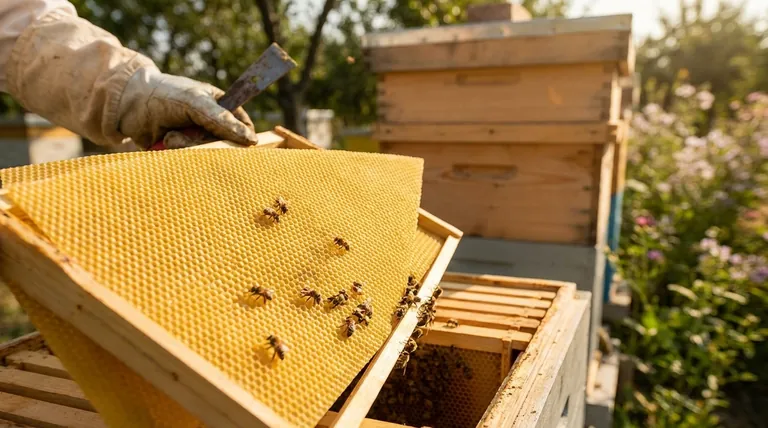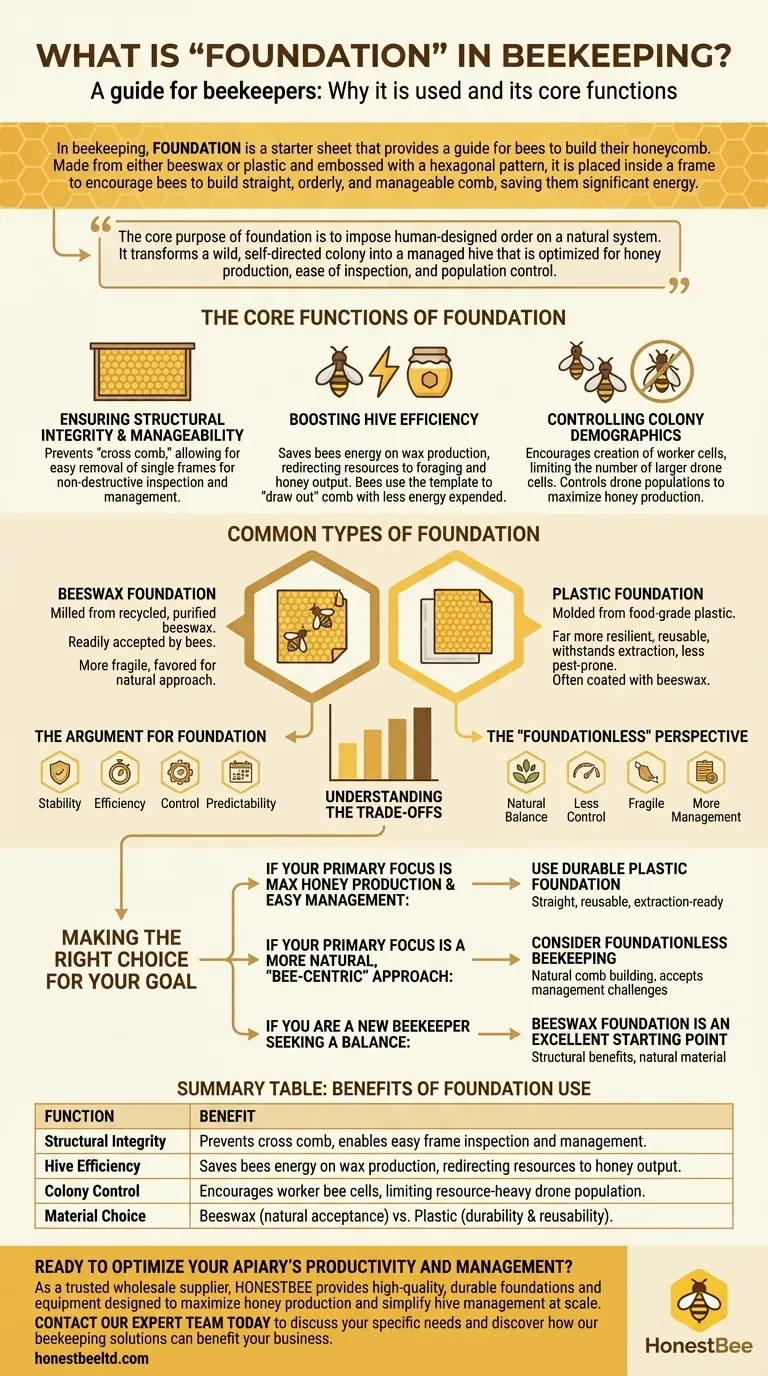In beekeeping, foundation is a starter sheet that provides a guide for bees to build their honeycomb. Made from either beeswax or plastic and embossed with a hexagonal pattern, it is placed inside a frame to encourage bees to build straight, orderly, and manageable comb, saving them significant energy in the process.
The core purpose of foundation is to impose human-designed order on a natural system. It transforms a wild, self-directed colony into a managed hive that is optimized for honey production, ease of inspection, and population control.

The Core Functions of Foundation
Bees in nature do not require foundation, but it has become a cornerstone of modern beekeeping because it solves several key challenges related to managing a colony.
Ensuring Structural Integrity and Manageability
Without guidance, bees will often build "cross comb," connecting and bridging multiple frames together. This makes it impossible for a beekeeper to remove a single frame for inspection without destroying large sections of honeycomb, brood, and honey stores.
Foundation guides the bees to build straight comb neatly within the confines of each removable frame. This is the single most important factor that allows for modern, non-destructive hive management and inspection.
Boosting Hive Efficiency
Producing beeswax is an energy-intensive process for honeybees. They must consume large amounts of nectar or honey (carbohydrates) to secrete tiny flakes of wax from their bodies.
By providing a foundation, the beekeeper gives the colony a significant head start. Bees can use the provided template to "draw out" the comb, expending far less energy on wax production and redirecting those resources toward foraging and producing more honey.
Controlling Colony Demographics
Foundation typically comes with a pre-stamped hexagonal pattern sized specifically for worker cells. Worker bees are the females that perform all the foraging, nursing, and hive maintenance.
By encouraging the creation of worker cells, foundation helps limit the number of larger drone cells. Drones are male bees whose primary function is to mate. An excessive drone population can strain a hive's resources, so controlling their numbers is a key management technique for maximizing honey production.
Common Types of Foundation
Beekeepers generally choose between two primary materials, each with distinct characteristics.
Beeswax Foundation
This foundation is milled from sheets of recycled, purified beeswax. Because it is made from their own natural building material, bees typically accept and build upon beeswax foundation very readily. It is more fragile than plastic but is favored by those seeking a more natural approach.
Plastic Foundation
Molded from durable, food-grade plastic, this type is far more resilient than wax. It can be reused for many years, withstands the force of mechanical honey extractors, and is less prone to damage by pests like wax moths. Most plastic foundation comes with a light coating of beeswax to encourage the bees to begin working on it.
Understanding the Trade-offs
The use of foundation is a management decision, and like any such decision, it comes with clear benefits and a different philosophy for those who choose to avoid it.
The Argument for Foundation
Using foundation leads to predictable, stable, and easily manageable hives. It maximizes the potential for honey extraction, simplifies inspections, and allows the beekeeper to exert control over the colony's composition. For any commercial or large-scale operation, its benefits are nearly indispensable.
The "Foundationless" Beekeeping Perspective
Some beekeepers choose to let bees build their own comb naturally within empty frames. This approach allows the colony to determine its own ratio of worker to drone comb, which proponents argue leads to a more balanced and natural hive ecosystem. This method requires more intensive management to prevent cross comb and results in more fragile honeycomb that cannot easily be put through a mechanical extractor.
Making the Right Choice for Your Goal
Your approach to using foundation should be directly tied to what you want to achieve with your bees.
- If your primary focus is maximum honey production and easy management: Use a durable plastic foundation to ensure straight, reusable combs that can withstand high-speed extraction.
- If your primary focus is a more natural, "bee-centric" approach: Consider foundationless beekeeping, allowing the bees to build their own comb while accepting the associated management challenges.
- If you are a new beekeeper seeking a balance: Beeswax foundation is an excellent starting point, as it provides the structural benefits of foundation while using a completely natural material.
Ultimately, your choice of foundation is a defining statement about your beekeeping philosophy and goals.
Summary Table:
| Function | Benefit |
|---|---|
| Structural Integrity | Prevents cross comb, enables easy frame inspection and management. |
| Hive Efficiency | Saves bees energy on wax production, redirecting resources to honey output. |
| Colony Control | Encourages worker bee cells, limiting resource-heavy drone population. |
| Material Choice | Beeswax (natural acceptance) vs. Plastic (durability & reusability). |
Ready to optimize your apiary's productivity and management?
As a trusted wholesale supplier for commercial apiaries and distributors, HONESTBEE provides the high-quality, durable foundations and equipment your operation needs to succeed. Our products are designed to maximize honey production and simplify hive management at scale.
Contact our expert team today to discuss your specific needs and discover how our beekeeping solutions can benefit your business.
Visual Guide

Related Products
- Beeswax Foundation Sheets Beehive Foundation for Wholesale
- Notebook Style Beeswax Foundation Mould Wax Foundation Mold
- Colorful Silicone Beeswax Foundation Mold Mould for Beekeeping
- Food Grade Plastic bee Foundation for Bee Frames
- Manual Beeswax Comb Foundation Machine Wax Foundation Mill Embossing Machine
People Also Ask
- What are the potential issues if the wax or dipping process is not properly managed? Avoid Cracks, Ripples, and Delamination
- What is beeswax foundation used for? A Guide to Efficient Hive Management
- What are the sizes of natural worker and drone cells? Guide to Natural Beehive Architecture
- How do beeswax foundations save bees time and energy? Boost Hive Productivity & Honey Yield
- What are the characteristics of beeswax foundation? A Natural Choice for Healthy Hives



















